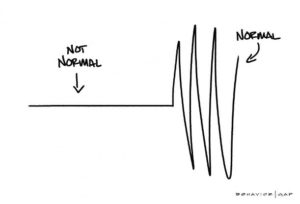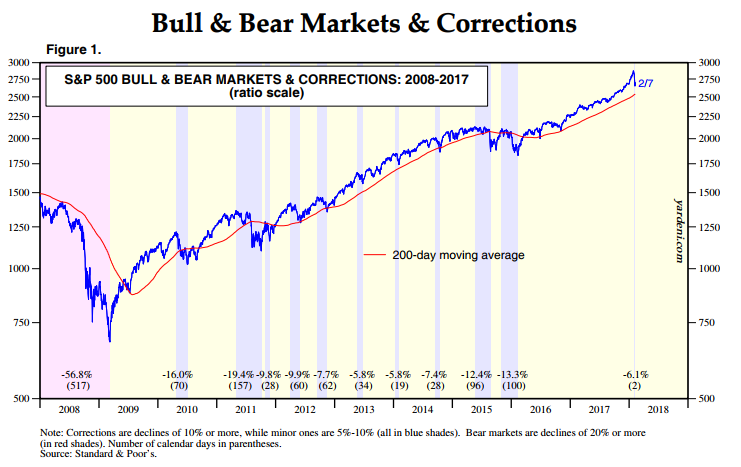What is “Normal”?
Over the last ten days the stock market has experienced higher levels of volatility than we’ve seen in some time. The result has been many headlines highlighting the downfall of a strong market. It’s left many people wondering if this is normal and healthy, or a sign of worse things to come.
But what is normal? In my experience, the only “Normal” setting I see is on the clothes dryer. Really normal is just a comparison of our experience today vs. our experience lately.
 Lately, there has been an absence of volatility. Think about it, we’ve haven’t seen a 10%+ drop in more than two years. That’s amazing, given that historically we’re taught to expect a drop of this magnitude about every 18 months. Step back for a little perspective and I think you’ll find the lack of volatility to be abnormal.
Lately, there has been an absence of volatility. Think about it, we’ve haven’t seen a 10%+ drop in more than two years. That’s amazing, given that historically we’re taught to expect a drop of this magnitude about every 18 months. Step back for a little perspective and I think you’ll find the lack of volatility to be abnormal.
It’s a saying you’ve heard us repeat: it is normal for the markets to experience a short-term decrease in prices, typically followed by a long-term advance. Those are the facts.
So if volatility is normal, what is abnormal about this situation? I’d say it’s the speed with which it is all happening.
In the 70s a typical market pullback took two years to play out (1973-1974). A more recent pullback took place from Dec. of 2015 through Jan. of 2016. That ~100-day pullback resulted in a price drop of 13.3%. With the holidays in full swing, you may not have even noticed it.
Now look at the current situation. The Dow hit 26,593 on Friday, Jan. 26th. Here we are on Feb. 9th, just two weeks (10 trading days) later at 23,860, a drop of about 10%. Like the Amazon Prime package that can reach you overnight, the pace of everything in this world seems to be getting quicker.
 I think the complexity of available financial products is contributing to this unusual speed. The financial services industry innovates by creating new and complex products that track everything from market volatility to collector stamps. These funds give “investors” entirely new ways to gamble on the market.
I think the complexity of available financial products is contributing to this unusual speed. The financial services industry innovates by creating new and complex products that track everything from market volatility to collector stamps. These funds give “investors” entirely new ways to gamble on the market.
One such product made headlines this week after its spectacular failure and drop of 96% in one day. The product was a complex bet against volatility. You can see how this was doomed from the start. But when investors and hedge funds use this as a way to hedge other risky bets, one domino falling can knock out several others in the broader markets.
This is why we invest in companies. Companies that make products. Companies that have a headquarters with a front door and a receptionist. Companies that produce the goods and services people use every day, everywhere. The market may wiggle, but the demand for tooth paste doesn’t often change. They’re simple, they’re understandable, and they’re the type of investments we want to be an owner of.
In our progress meetings we refer to times like these as a fire drill. When the alarm goes off what are we going to do? We are going to be calm, relax, and follow your plan. We are not going to react with emotion. That is the smart way to deal with a fire drill. That’s the same behavior to have in times like today.
We see this correction as normal and possibly a great opportunity for those with a long time horizon. But market drops are never fun, they never feel good. So if you’re feeling concerned or in need of some guidance please give us a call. We’re here to help, advise, and provide perspective on situations just like this.
Steve Booren is the Owner and Founder of Prosperion Financial Advisors, located in Greenwood Village, Colo. He is the author of Blind Spots: The Mental Mistakes Investors Make and Intelligent Investing: Your Guide to a Growing Retirement Income and a regular columnist in The Denver Post. He was recently named a Barron’s Top Financial Advisor and recognized as a Forbes Top Wealth Advisor in Colorado.
The S&P 500 Index is a capitalization-weighted index of 500 stocks designed to measure performance of the broad domestic economy through changes in the aggregate market value of 500 stocks representing all major industries.
Investing involves risks, including possible loss of principal. No investment strategy or risk management technique can guarantee return or eliminate risk in all market environments.








